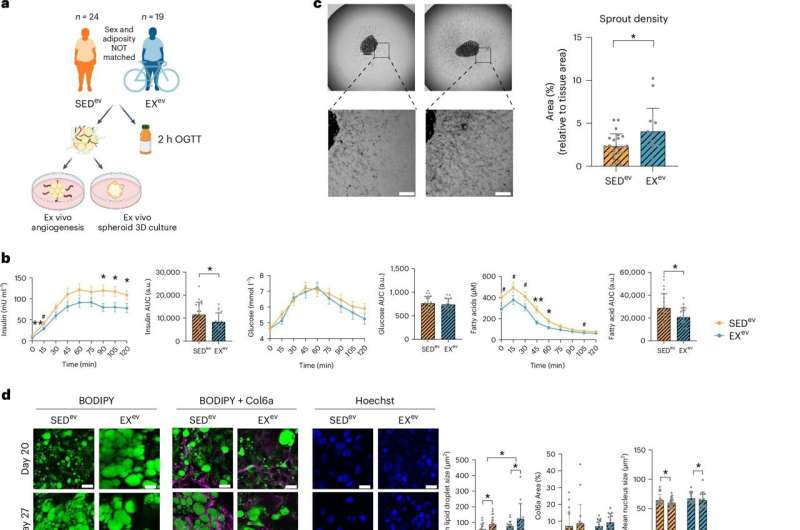This article has been reviewed according to Science X's editorial process and policies. Editors have highlighted the following attributes while ensuring the content's credibility:
fact-checked
peer-reviewed publication
trusted source
proofread
Long-term exercisers have 'healthier' belly fat, study reveals

People with obesity who are long-time exercisers have healthier belly fat tissue and can store fat there more effectively than nonexercisers with obesity, according to a new study from a team of researchers at the University of Michigan.
The study, "Long-term exercise training has positive effects on adipose tissue in overweight or obesity," appears Sept. 10 in Nature Metabolism.
The research team also grew fat tissue in the lab from cells collected from both exercisers and nonexercisers, and cells from the exercisers developed into a tissue that stored fat more effectively.
"Our findings indicate that in addition to being a means to expend calories, exercising regularly for several months to years seems to modify your fat tissue in ways that allows you to store your body fat more healthfully if or when you do experience some weight gain––as nearly everyone does as we get older," said principal investigator Jeffrey Horowitz, professor of movement science at the U-M School of Kinesiology.
Researchers wanted to see the effects of years of regular exercise on fat tissue, but it's very difficult to design a study to track this long term. Instead, they compared two groups of adults with obesity: 16 people who reported exercising at least four times a week for at least two years—the average was 11 years; and 16 people who'd never exercised regularly but matched in other things like body fat mass, weight and sex. The team took samples of belly fat tissue just under the skin from both groups.
They found that the exercisers had distinct structural and biological characteristics in their fat tissue that increased the capacity to store fat there. The nonexercisers did not have those characteristics. Specifically, the exercisers had more blood vessels, mitochondria and beneficial proteins, and less of a type of collagen that can interfere with metabolism and fewer cells that cause inflammation.
This matters because the healthiest place to store fat is the fat tissue just under the skin where the samples were taken, called subcutaneous adipose tissue. Increasing the capacity to store fat here through exercise reduces the need to store fat in unhealthy places, like in the fat tissue around the organs or in the organs themselves.
"Compared with our previous study in which we examined the effects of three months of training on fat tissue, we generally see these differences are more robust in people who exercise regularly for years versus those who don't exercise," Horowitz said.
It's important to note that increasing the capacity to store fat does not equate to gaining fat, which requires overeating.
"What it means is that if or when people experience weight gain, this excess fat will be stored more 'healthfully' in this area under the skin, rather than in the fat tissue around their organs (visceral fat) or an accumulation of fat in organs themselves, like the liver or heart."
One disease caused by unhealthy fat accumulation that's getting more attention in the U.S. and elsewhere is nonalcoholic fatty liver disease, which occurs most often in people with overweight or obesity. Excess fat builds up in the liver and can cause diseases like cirrhosis (seen most often with alcoholism) or cancer.
Horowitz said it's important to perform long-term studies to track people as they start and maintain an exercise program for several years to see how their fat tissue changes—even if they don't change the amount of fat tissue they have. It's also important to know if there is a type or intensity of exercise that achieves a better response in modifying fat tissue.
In follow-up studies, the team will also examine whether the fat tissue grown from exercisers and nonexercisers functions differently, and if there are other health-related differences that may translate to the health of the tissue and the person the cells came from.
More information: Cheehoon Ahn et al, Years of endurance exercise training remodel abdominal subcutaneous adipose tissue in adults with overweight or obesity, Nature Metabolism (2024). DOI: 10.1038/s42255-024-01103-x




















